
The Schenk von Stauffenberg family is a noble (Uradel) Roman Catholic family from Swabia in Germany. The family's best-known recent member was Colonel Claus Schenk Graf von Stauffenberg – the key figure in the 1944 "20 July plot" to assassinate Adolf Hitler.
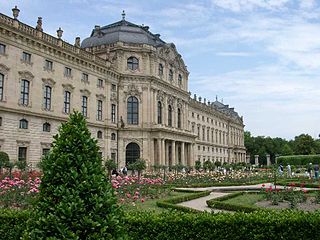
The Würzburg Residence is a palace in Würzburg, Germany. Johann Lukas von Hildebrandt and Maximilian von Welsch, representatives of the Austrian/South German Baroque style, were involved in the construction, as well as Robert de Cotte and Germain Boffrand, who were followers of the French Style. Balthasar Neumann, court architect of the Bishop of Würzburg, was the principal architect of the Residence, which was commissioned by the Prince-Bishop of Würzburg Johann Philipp Franz von Schönborn and his brother Friedrich Carl von Schönborn in 1720, and completed in 1744. The Venetian painter Giovanni Battista Tiepolo, assisted by his son, Domenico, painted frescoes in the building.
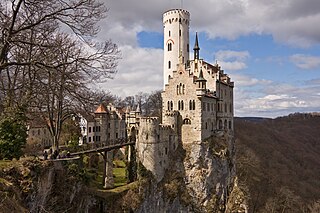
Lichtenstein Castle is a privately-owned Gothic Revival castle located in the Swabian Jura of southern Germany. It was designed by Carl Alexander Heideloff and its name means "shining stone" or "bright stone". The castle overlooks the Echaz valley near Honau, Reutlingen in the state of Baden-Württemberg. The modern castle was inspired by the novel Lichtenstein (1826) by Wilhelm Hauff and was built in 1840–1842. The ruins of an older medieval castle are a few hundred meters away.

Jakob Fuggerof the Lily, also known as Jakob Fuggerthe Rich or sometimes Jakob II, was a major German merchant, mining entrepreneur, and banker. He was a descendant of the Fugger merchant family located in the Free Imperial City of Augsburg, where he was born and later also elevated through marriage to Grand Burgher of Augsburg. Within a few decades he expanded the family firm to a business operating in all of Europe. He began his education at the age of 14 in Venice, which also remained his main residence until 1487. At the same time he was a cleric and held several prebendaries, even though he never lived in a monastery. Fugger is held to be one of the wealthiest individuals in modern history, alongside the early 20th century industrialists John D. Rockefeller and Andrew Carnegie.

St. Emmeram's Abbey, now known as Schloss Thurn und Taxis, Schloss St. Emmeram, and St. Emmeram's Basilica, was a Benedictine monastery founded in about 739 in Regensburg in Bavaria at the grave of the itinerant Frankish bishop Saint Emmeram.

The Electorate of Trier, traditionally known in English by its French name of Trèves, was an ecclesiastical principality of the Holy Roman Empire that existed from the end of the 9th to the early 19th century. It consisted of the temporal possessions of the prince-archbishop of Trier, also a prince-elector of the empire, along with the Elector of Cologne and the Elector of Mainz, among which the latter ranked first.
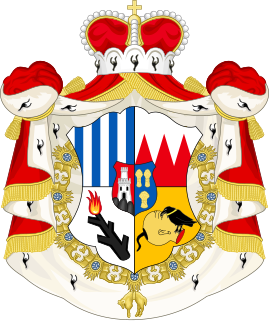
Schwarzenberg is a German (Franconian) and Czech (Bohemian) aristocratic family, and it was one of the most prominent European noble houses. The Schwarzenbergs are members of the German nobility and Czech nobility and they held the rank of Princes of the Holy Roman Empire. The family belongs to the high nobility and traces its roots to the Lords of Seinsheim during the Middle Ages.
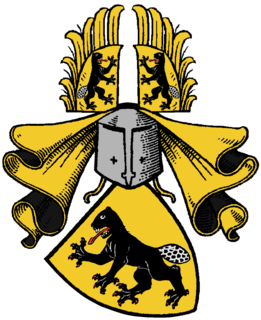
The Bibra family was one of the leading Uradel families in Franconia and present day Thuringia from the mid-15th century to about 1600. Later on the family rose from Reichsritter to Reichsfreiherr. After the Holy Roman Empire dissolved, they were made ‘’Freiherr’‘ (Barons) of Bavaria and Bohemia.

Archduke Franz Ferdinand Carl Ludwig Joseph Maria of Austria was the heir presumptive to the throne of Austria-Hungary. His assassination in Sarajevo is considered the most immediate cause of World War I.

Glonn is a market town in the Ebersberg district in Upper Bavaria, Germany, about 30 km (19 mi) southeast of Munich.

Brennhausen is a castle in the municipality of Sulzdorf a.d.Lederhecke in the district of Rhön-Grabfeld in Bavaria in Germany. It is located the Haßberge Nature Park.

Jossgrund is a municipality in the Main-Kinzig district, in Hesse, Germany. It has around 3,500 inhabitants distributed among several formerly independent villages, now Ortsteile. The administration seat is at Oberndorf.
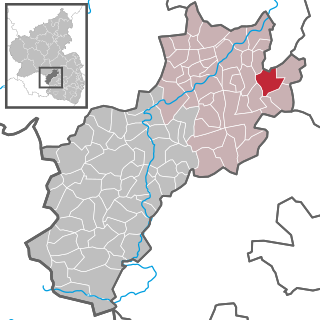
Reipoltskirchen is an Ortsgemeinde – a municipality belonging to a Verbandsgemeinde, a kind of collective municipality – in the Kusel district in Rhineland-Palatinate, Germany. It belongs to the Verbandsgemeinde Lauterecken-Wolfstein.
John I of Isenburg-Limburg, "The blind Lord" was from 1289 Count of (Isenburg-) Limburg and the head of the House of Limburg. The core territory of the Lordship of Limburg consisted of the city of Limburg an der Lahn and several surrounding villages.

Duchess Therese Mathilde Amalie of Mecklenburg-Strelitz was a member of the House of Mecklenburg-Strelitz and a Duchess of Mecklenburg. Through her marriage to Karl Alexander, 5th Prince of Thurn and Taxis, Therese was also a member of the House of Thurn and Taxis.

Schloss Matzen is a historic Austrian castle, located in the Tyrol near the branch of the Zillertal from the main Inn valley. Strategically located to control one of the major transalpine trade routes, the origins of the castle date from Roman times and it has a distinctive round tower thought to be of possible Roman derivation. The castle, mostly Gothic in origin is one of the most important surviving historic buildings of the Tyrol.

Himmelpforten Convent was founded as a monastery of nuns following the Cistercian Rule during the 13th century in Himmelpforten, in today's Lower Saxony, Germany. During the 16th century, it was converted into use as a Lutheran Damsels' Convent. The Himmelpforten Convent was founded before 1255 and finally dissolved in 1647. The convent complex was built between 1300 and 1330. After 1645 the buildings, including the abbey, increasingly decayed, until they were little by little demolished. The dilapidated abbey was demolished in 1737 and replaced by today's St. Mary's Church which partially covers the foundations of the former abbey.
The House of Egloffstein is an ancient Franconian aristocratic family (Uradel) with an eponymous family home in the hill region of Franconian Switzerland in the Bavarian province of Upper Franconia. The family first appears in the records in 1187 with a Heinrich genannt Stuchs who is also the progenitor. The house belongs to the brotherhood of Franconian Imperial Knights.


















